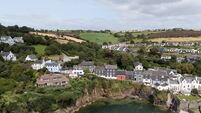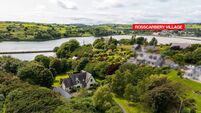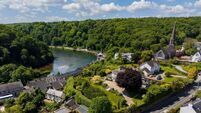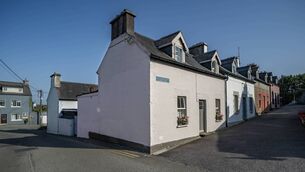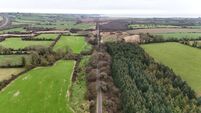Super-renovated Ouvane has the oo! factor
NFS. Those words, denoting ‘Not For Sale’ always seem to hang on the pictures or art works in a gallery that someone desperately wants to buy.
The same ‘NFS’ applies to this top-to-toe renovated Douglas, Cork semi: “I don’t think I’ll leave here, except in a box,” says owner of this desirable des.res., Derek O’Leary.
A returned Corkman, and a practising architect, and his Dublin-born wife Annik Twomey O’Leary, and their two young sons, bought the mature 1950s semi in the Douglas suburb just a couple of years ago when Derek came south to open up John Duffy Architecture after soujourns in Leinster and the capital.
Derek and Annik (who works in a bank), have been both design team and clients here, so there’s probably been as good a trade of pros and cons: the buck stops with them, in every sense. No-one else to blame. But, no one else to claim the credit either.
They’ve just recently finished its overhaul, which took a full nine months (Feb ‘06 to November, done and dusted, chimneys swept for Santa for Christmas.) While the re-worked front elevation gives clues to the fact it has been given a contemporary once-over, the back extension really confirms it. It has the wow! factor.
With the cost of moving house, trading up, paying stamp duty and fees, there’s ideas here ripe for stealing by those already in an older semi, looking for more space, and looking for a more modern home.
Just stay put, get in the professionals, pay for design, and keep in with the neighbours.
“We had the ‘look,’ in our heads, for about ten years, though we didn’t have the house. I suppose we knew with that our budget, we’d end up in the suburbs, in a semi or maybe a detached home, and we’d only looked at a few when we saw this house. It had been ‘sale agreed,’ but that sale fell through, and we made the successful bid as soon as we viewed. That was it,” they said.
“We didn’t re-invent the wheel here, we just borrowed and stole good ideas that we knew would work, and we wanted open plan for a family home” says Derek.
During the building, extending and structural changes, they lived in this house through the work, camped out or variously fenced in behind screening plastic sheeting while the dirty work continued inches away.
And, after it all, they still highly rate and praise their builder, Greg O’Sullivan, who specialises in the sometimes awkward work of extensions and upgrades as well as doing larger projects like schools.
Verily, it can be done, so if an SSIA pay-off is about to spring-board you into house work, be brave.
The original home was a three-bed semi, or about 1,000 sq ft, and in a familiar layout, the sort of shape that builders haven’t changed in decades. Annik and Derek added about 700 more square feet, putting a master bedroom, walk-in robes and en suite bathroom to the side, with enough space left underneath it for side access to the back garden and kitchen/utility, for recycling containers, bins and bike storage and all the accoutrement that go with young family life. (Derek rightly reckons storage for recycling is going to be one of the challenges that has to be accommodated in all modern homes.)
But, the back is the best of all, and what they’ve done here is just the sort of achievable thing that can give single storey extensions a good name.
The back wall of the north-facing extension is virtually all glass, with large barn-sized sliding doors made by the Danish company Carlson, whose Irish operation can guarantee delivery within six weeks, notes Derek.
The rear reception room opens out into this space at one side, thanks to the supporting wonders of RSJ steel and exposed steel girders, painted in a fire-rated paint, are a design feature in the back of the extension too with the natural wood stain finish on the doors.
Decking, set at the exact same height as the extension’s walnut floor, keeps the ‘room outside’ feel and encourages an easy flow between both, and as the aspect is northerly, the family are inclined to gravitate to the end of the garden in evening times to catch the sun. Every inch of garden space will be used, one suspects, and as proof of the commitment to quality, even the ‘shed’ is made of teak.
The kitchen is a sectioned affair, with high-gloss Kappa units and dark wood (oak laminate) worktops and splashback continued up the wall. There’s a black Aga range to the rear in an enclave, and then there’s a long, galleried area, a real cook’s space with lots of prep and serving surfaces, looking over worktops to the open plan eating/living room, with 1950s Danish design furniture making a comeback, courtesy of Habitat’s 20th Century Furniture concession. Other furniture was made by Derek’s brother Fergal, a joiner with the highly-regarded Hans Leptien.
The ceiling is a single-pitch, sloping roof with two large flat glazed panels set into it to ensure light still gets into the core of the house (and the fact the two ‘original’ reception roms, front and back, have linking double doors with glass keeps the light flowing through too.) The external finish is a high-quality Trocal material, a far cheaper alternative to the look of standing seam metal such as zinc, lead or copper.
Any family looking for the look and keen to stay put in a well-set semi might just have one question to ask: How much?
Reckon on €150 per square foot for the build, and in Annik and Derek’s case, this covered all the building fundamentals, but not the final discretionary finishes such as flooring, kitchen units, tiling, decoration and lighting. At this level, you get what you pay for. In this successfully made-over home, it looks like they got more than they bargained for. Helps to have a pro in the house.






